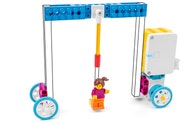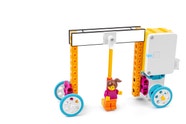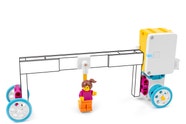SPIKE™ Essential
Winning Goal
How can Maria’s football match be more like a computer game?
30-45 min.
Beginner
Years 3-5

Prepare
- Review the Winning Goal lesson in the LEGO® Education SPIKE™ App.
- If you feel that it would be beneficial, pre-teach these related vocabulary words: compare, contrast and failure.
- Consider the abilities and backgrounds of all your pupils. Differentiate the lesson to make it accessible to everyone. Please refer to the Differentiation section below for suggestions on how to do this.
- If time permits, plan and facilitate the language arts extension. Please refer to the Extension section below for further information.
Engage
(Whole Class, 5 Minutes)
- Facilitate a quick discussion about failure.
- Talk with your pupils about a time when they tried to complete a task or an activity but couldn’t (e.g. not being able to make a save during a football match).
- Ask questions like these: How did it feel to fail? How did you change your approach so that you would succeed the next time?
- Introduce your pupils to the story’s main characters and the first challenge: moving the goal.
- Distribute a brick set and a device to each group.
Explore
(Small Groups, 30 Minutes)
- Have your pupils use the LEGO® Education SPIKE™ App to guide them through their first challenge:
- Create and test the program that moves the goal.
- Have your pupils iterate and test their models to complete the next two challenges in the app:
- Modify the program to make the goal move differently.
- Design your own upgraded moving goal.
- You can find coding and building help in the Tips section below.
Explain
(Whole Class, 5 Minutes)
- Gather your pupils together to reflect on their completed challenges.
- Ask questions like these: How did you modify the program to make the goal move differently? What did you consider when you designed your own moving goal?
Elaborate
(Whole Class, 5 Minutes)
- Prompt your pupils to discuss and reflect on the process of identifying the failure points of a model or program.
- Ask questions like these: How could you determine when the goal failed? What did you observe? How could you use these observations to make it a success in the future?
- Have your pupils tidy up their workstations.
Evaluate
(Ongoing Throughout the Lesson)
- Ask guiding questions to encourage your pupils to ‘think aloud’ and explain their thought processes and reasoning in the decisions they’ve made while building and programming their models.
Observation Checklist
- Measure your pupils’ proficiency in identifying the failure points of a model or program.
- Establish a scale that suits your needs. For example:
- Requires additional support
- Can work independently
- Can teach others
Self-Assessment
Have each pupil choose the brick that they feel best represents their performance.
- Yellow: I think that I can identify the failure points of a model or
program. - Blue: I can identify the failure points of a model or program.
- Green: I can identify the failure points of a model or program, and I
can also help a friend to do it.
Peer Feedback
- In their small groups, have your pupils discuss their experiences of working together.
- Encourage them to use statements like these:
- I liked it when you…
- I'd like to hear more about how you…
Tips
Coding Tips
- After your pupils have completed their first challenge, they'll be provided with three Inspiration Coding Blocks, which will help them to modify their programs.
- The Inspiration Coding Blocks are intended to spark their imaginations as they experiment to find their own solutions.




Model Tip
- After your pupils have completed their second challenge, they’ll be provided with three Inspiration Images and an open-ended prompt, which will help them to improve their models.
- The Inspiration Images are meant to help spark their imaginations as they experiment and personalise their models.




There are no specific building instructions for this challenge.
Differentiation
Simplify this lesson by:
- Selecting one Inspiration Image to help your pupils personalise their models
- Experimenting with either the coding or the building
Increase the difficulty by:
- Creating a program for another group and having them try to score a goal
- Adding the light to the goal, then programming it to act as a countdown clock
Extension
- Have your pupils write a sports commentary for Maria and Sofie’s football match. Make sure that they use correct sports terminology and directional vocabulary.
If facilitated, this will extend beyond the 45-minute lesson.
Language Arts: National Curriculum English En5/3.3 Composition b
Teacher Support
The pupils will:
- Identify the failure points of a model or program
- Consider failure points in order to make improvements
- Engage effectively in a range of collaborative discussions
(one for every two pupils)
- LEGO® Education SPIKETM Essential Set
- Device with the LEGO® Education SPIKE™ App installed
National Curriculum
Computing
Co2/1.1
- design, write and debug programs that accomplish specific goals, including controlling or simulating physical systems; solve problems by decomposing them into smaller parts
Co2/1.3 - use logical reasoning to explain how some simple algorithms work and to detect and correct errors in algorithms and programs
English
En5/1g
- use spoken language to develop understanding through speculating, hypothesising, imagining and exploring ideas
En5/3.3b
Draft and write by: - selecting appropriate grammar and vocabulary, understanding how such choices can change and enhance meaning
- in narratives, describing settings, characters and atmosphere and integrating dialogue to convey character and advance the action
- précising longer passages
- using a wide range of devices to build cohesion within and across paragraphs
- using further organisational and presentational devices to structure text and to guide the reader




